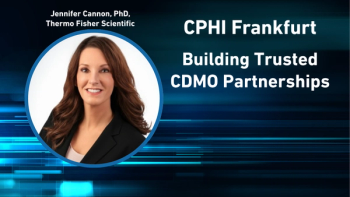
- Pharmaceutical Technology-08-01-2009
- Volume 2009 Supplement
- Issue 43
Growing Pains
As the pharmaceutical supply chain expands, sponsor companies need to weigh all their options.
Outsourcing has increasingly become the mark of good resource management on the part of modern pharmaceutical companies. Why invest in equipment, machinery, space, and human resources for a novel process or product, and why spend time slogging up the learning curve, if you can find a partner company who already has the skill and equipment to move your project forward? This realization is especially relevant for firms entering new markets, manufacturing new drug types, or using novel formulations and delivery mechanisms.
Michelle Hoffman
Outsourcing can be an attractive alternative for products in any stage of development, from early-stage formulation and process development through commercial-scale production. By outsourcing, the client company maximizes efficiency—freeing up time, personnel, and equipment to do what it does best, and at the same time reduces its investment exposure and capital expenditures. The partnership can be quite reasonable, but does not come without its own challenges.
For in outsourcing, a sponsor company is giving up a good deal of control and has to balance the risk and rewards of keeping a project in-house with those of working with external partners. This challenge, although always present in any outsourced relationship, becomes more difficult with increased complexity in the supply chain. The basic expectations and requirements for the client and the outsource service provider have not changed. On-time delivery, meeting product specifications, regulatory compliance, and product quality remain the cornerstone of any successful outsourced relationship.
The outsourcing relationship, however, increasingly operates in a truly global pharmaceutical supply chain through the supply of raw materials, ingredients, or the delivery of the contract services themselves. And with the elongation of the supply chain comes attendant obligations and costs in securing that supply chain.
We've heard tales from firms that the cost of their due diligence can exceed the cost of the service contract, at least for the initial project. Furthermore, it's been estimated that the pharmaceutical industry collectively performs 800,000 audits each year to ensure the quality of its suppliers in the US and abroad. That's got to use up a lot of resources (not to mention paper).
It is for this reason we applaud and encourage efforts such as those of the Rx-360 consortium, an industry initiative, which held its launch meeting in June, with an overarching mission of supporting product quality and authenticity throughout the supply chain. Among the group's efforts is to explore the feasibility, acceptability, and potential approaches for shared supplier audits.
The consortium seeks to develop a system that will make audits broader and more thorough and will allow firms to share audit findings and corrective actions, making the system more effective and efficient. Each consortium member company could use this information for its own independent assessments on the appropriateness of a supplier based on their own company policies and product needs. Obviously, the needs of each client may differ, and standardizing audit information to make it useful to the greatest number of clients in the greatest number of cases won't be easy. Nevertheless, the ultimate saving in time alone could be worth its weight in—well, if not gold, at least in paper.
Michelle Hoffman is editor-in-chief of Pharmaceutical Technology. Send your thoughts and story ideas to
Articles in this issue
over 16 years ago
Pharma Industry Consortium Rx-360 Tackles Supply-Chain Securityover 16 years ago
Industry Outlook: Down But Not Outover 16 years ago
The Future of Pharmaceutical CMC Outsourcingover 16 years ago
Outsourcing Stability Studiesover 16 years ago
Waivers and Deferrals Under the Pediatric Research Equity Actover 16 years ago
European Requirements for Pediatric Formulationsover 16 years ago
Pediatric Formulations: Technical and Regulatory Considerationsover 16 years ago
Global Outsourcing: A Roundtable of Contract ManufacturersNewsletter
Get the essential updates shaping the future of pharma manufacturing and compliance—subscribe today to Pharmaceutical Technology and never miss a breakthrough.




